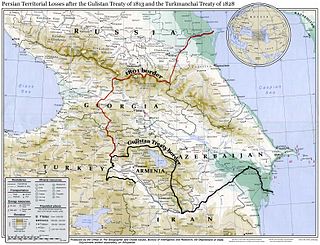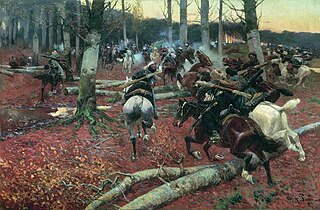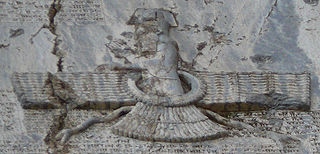Related Research Articles

Ctesiphon was an ancient city in modern Iraq, on the eastern bank of the Tigris, about 35 kilometres (22 mi) southeast of Baghdad. Ctesiphon served as a royal capital of the Iranian empires for over eight hundred years, in the Parthian and Sasanian periods. Ctesiphon was the capital of the Sasanian Empire from 226–637 until the Muslim conquest of Persia in 651 AD.

The Treaty of Gulistan was a peace treaty concluded between the Russian Empire and Qajar Iran on 24 October 1813 in the village of Gulistan as a result of the first full-scale Russo-Persian War. The peace negotiations were precipitated by the successful storming of Lankaran by General Pyotr Kotlyarevsky on 1 January 1813. It was the first of a series of treaties signed between Qajar Iran and Imperial Russia that forced Persia to cede the territories that formerly were part of Iran.

The Treaty of Turkmenchay was an agreement between Qajar Iran and the Russian Empire, which concluded the Russo-Persian War (1826–1828). It was second of the series of treaties signed between Qajar Iran and Imperial Russia that forced Persia to cede or recognize Russian influence over the territories that formerly were part of Iran.

Prince Alexander of Georgia was a Georgian royal prince (batonishvili) of the Bagrationi dynasty, who headed several insurrections against the Russian rule in Georgia. He was known as Eskandar Mīrzā (اسکندرمیرزا) in Persia, tsarevichAleksandr Irakliyevich in Russia, and Alexander Mirza in Western Europe.

The Caucasian War or the Caucasus War was a 19th-century military conflict between the Russian Empire and various peoples of the North Caucasus who resisted subjugation during the Russian conquest of the Caucasus. It consisted of a series of military actions waged by the Russian Imperial Army and Cossack settlers against the native inhabitants such as the Adyghe, Abaza-Abkhazians, Ubykhs, Chechens, and Dagestanis as the Tsars sought to expand.

Greater Iran or Greater Persia, also called the Iranosphere or the Persosphere, is an expression that denotes a wide socio-cultural region comprising parts of West Asia, the Caucasus, Central Asia, South Asia, and East Asia —all of which have been affected, to some degree, by the Iranian peoples and the Iranian languages.

Prince Ivane Andronikashvili was a Russian general from the Georgian noble Andronikashvili family.

Abbasgulu agha Bakikhanov, Abbas Qoli Bakikhanov, or Abbas-Qoli ibn Mirza Mohammad (Taghi) Khan Badkubi was an Azerbaijani writer, historian, journalist, linguist, poet and philosopher. He was son of the third khan of Baku Mirza Muhammad Khan II. Served as an officer in the Imperial Russian Army and participated in the Russo-Persian War of 1826–1828, he later retired and settled in Quba.

Yevhen Pavlovych Hrebinka was a Ukrainian romantic prose writer, poet, and philanthropist. He wrote in both the Ukrainian and Russian languages. He was an older brother of the architect Mykola Hrebinka.

Babylon was an ancient city located on the lower Euphrates river in southern Mesopotamia, within modern-day Hillah, Iraq, about 85 kilometers south of modern day Baghdad. Babylon functioned as the main cultural and political centre of the Akkadian-speaking region of Babylonia. Its rulers established two important empires in antiquity, the 19th–16th century BC Old Babylonian Empire, and the 7th–6th century BC Neo-Babylonian Empire. Babylon was also used as a regional capital of other empires, such as the Achaemenid Empire. Babylon was one of the most important urban centres of the ancient Near East, until its decline during the Hellenistic period. Nearby ancient sites are Kish, Borsippa, Dilbat, and Kutha.

Khomarlu is a city in the Central District of Khoda Afarin County, East Azerbaijan province, Iran, serving as capital of both the county and the district. The city also serves as the administrative center for Keyvan Rural District.

Xavier Pascal Coste was a French architect. He was at one time a personal architect for Muhammad Ali Pasha. As a seasoned traveller, his travels to Qajar Iran, aroused the interest of King Louis Philippe I and that gained Coste the post of chief architect of Marseille in 1844.
William Francis Ainsworth was an English surgeon, traveller, geographer, and geologist, known also as a writer and editor.
William Francklin (1763–1839) was an English orientalist and army officer.
The following is a timeline of the history of the city of Baghdad, Iraq.
John George Taylor was a British official of the Foreign Office, and also an important early archaeologist investigating the antiquities of the Middle East. He was one of the first archaeologists to explore the prominent burial mounds in the area of the Persian Gulf, and he made some very important discoveries. He also worked for the British East India Company.

Kavanaq is a village in Dizmar-e Sharqi Rural District, Minjavan District, Khoda Afarin County, East Azerbaijan Province, Iran. At the 2006 census, its population was 81, in 21 families. According to more recent statistics the population is 94 people in 22 families.

Mardanaqom is a village in, and the capital of, Dizmar-e Sharqi Rural District of Minjavan District, Khoda Afarin County, East Azerbaijan province, Iran.
Bussorah Merchant was a merchant ship built at Calcutta in 1818. She made three voyages transporting convicts from England and Ireland to Australia and later carried emigrants and other passengers to Australia.
Ismayil bek Kutkashensky was Imperial Russian general of Azerbaijani background. In addition to being author of the first Azerbaijani literary work in French language, he is also known to be first Azerbaijani ever to be decorated with Order of St. George - the highest military decoration of the Russian Empire.
References
- 1 2 Boase, Frederic, ed. (1897). "Mignan, Robert". Modern English Biography: I-Q. Netherton and Worth. p. 869.
- ↑ Marshall, Brian (1994). "European Travellers in Oman and Southeast Arabia 1795–1950: A Biobibliographical Study". In Bidwell, R.L.; Rex Smith, G; Smart, J.R. (eds.). New Arabian Studies 2. University of Exeter Press. pp. 20–21. ISBN 9780859894524.
- ↑ Hilprecht, Hermann Vollrat (2011) [1904]. The Excavations in Assyria and Babylonia. Cambridge University Press. pp. 51–52. ISBN 9781108025645.
- ↑ Cross, Anthony (2014). In the lands of the Romanovs: an annotated bibliography of first-hand English-language accounts of the Russian Empire (1613-1917). Open Book Publishers. p. 155. ISBN 9781783740574.